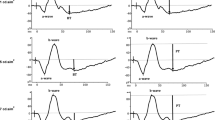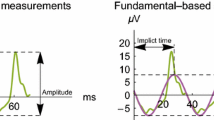Abstract
The aim of this study was to investigate the relationship between stimulus intensity and response amplitude for the photopic negative response (PhNR) of the flash ERG. Specific aims were (i) to determine whether a generalized Naka–Rushton function provided a good fit to the intensity–response data and (ii) to determine the variability of the parameters of the best-fitting Naka–Rushton models. Electroretinograms were recorded in 18 participants, on two occasions, using both DTL fibre and skin active electrodes, in response to Ganzfeld red stimuli (Lee filter “terry red”) ranging in stimulus strength from −1.30 to 0.53 log cd.s.m−2 (0.28–2.11 log phot td.s) presented over a steady blue background (Schott glass filter BG28; 3.9 log scot td). PhNR amplitude was measured from b-wave peak and from pre-stimulus baseline. The Naka–Rushton function was fitted to all intensity–response data, and parameters, ‘n’, ‘Vmax’ and ‘K’ were obtained. Coefficients of variation (CoV), and inter-ocular and inter-session limits of agreement (LoA) were calculated for both Naka–Rushton parameters. A generalized Naka–Rushton function was found to provide a good fit to the intensity–response data, except at the highest stimulus intensity, where a reduction in amplitude occurred in many individuals. The ‘Vmax’ parameter was less variable than ‘K’ for all intensity–response data. Variability was lower for DTL than skin electrodes, and for peak-to-trough PhNR measurements, compared to baseline-to-trough. This study has demonstrated for the first time that the Naka–Rushton model provides a useful means of quantifying the intensity–response relationship of the PhNR.





Similar content being viewed by others
Abbreviations
- PT:
-
Peak-to-trough
- BT:
-
Baseline-to-trough
References
Viswanathan S, Frishman LJ, Robson JG, Harwerth RS, Smith EL (1999) The photopic negative response of the macaque electroretinogram: reduction by experimental glaucoma. Invest Ophth Vis Sci 40(6):1124–1136
Colotto A, Falsini B, Salgarello T, Iarossi G, Galan ME, Scullica L (2000) Photopic negative response of the human ERG: Losses associated with glaucomatous damage. Invest Ophth Vis Sci 41(8):2205–2211
Drasdo N, Aldebasi YH, Chiti Z, Mortlock KE, Morgan JE, North RV (2001) The s-cone PhNR and pattern ERG in primary open angle glaucoma. Invest Ophth Vis Sci 42(6):1266–12724
Fortune B, Bui BV, Cull G, Wang L, Cioffi GA (2004) Inter-ocular and inter-session reliability of the electroretinogram photopic negative response (PhNR) in non-human primates. Exp Eye Res 78(1):83–93
Gotoh Y, Machida S, Tazawa Y (2004) Selective loss of the photopic negative response in patients with optic nerve atrophy. Arch Ophthalmol 122(3):341–346
Kizawa J, Machida S, Kobayashi T, Gotoh Y, Kurosaka D (2006) Changes of oscillatory potentials and photopic negative response in patients with early diabetic retinopathy. Jpn J Ophthalmol 50(4):367–373
Machida S, Gotoh Y, Tanaka M, Tazawa Y (2004) Predominant loss of the photopic negative response in central retinal artery occlusion. Am J Ophthalmol 137(5):938–940
Machida S, Gotoh Y, Toba Y, Ohtaki A, Kaneko M, Kurosaka D (2008) Correlation between photopic negative response and retinal nerve fiber layer thickness and optic disc topography in glaucomatous eyes. Invest Ophth Vis Sci 49(5):2201–2207
Rangaswamy NV, Frishman LJ, Dorotheo EU, Schiffman JS, Bahrani HM, Tang RA (2004) Photopic ERGs in patients with optic neuropathies: comparison with primate ERGs after pharmacologic blockade of inner retina. Invest Ophth Vis Sci 45(10):3827–3837
Rangaswamy NV, Shirato S, Kaneko M, Digby BI, Robson JG, Frishman LJ (2007) Effects of spectral characteristics of ganzfeld stimuli on the photopic negative response (PhNR) of the ERG. Invest Ophth Vis Sci 48:4818–4828
Sustar M, Cvenkel B, Brecelj J (2009) The effect of broadband and monochromatic stimuli on the photopic negative response of the electroretinogram in normal subjects and in open-angle glaucoma patients. Doc Ophthalmol 118(3):167–177
Viswanathan S, Frishman LJ, Robson JG, Walters JW (2000) The photopic negative response of the flash electroretinogram (ERG) in primary open angle glaucoma. Invest Ophth Vis Sci 41(4):1533 B1908
Viswanathan S, Frishman LJ, Robson JG, Walters JW (2001) The photopic negative response of the flash electroretinogram in primary open angle glaucoma. Invest Ophth Vis Sci 42(2):514–522
Bach M, Hoffmann MB (2008) Update on the pattern electroretinogram in glaucoma. Optometry Vision Sci 85(6):386–395
Bach M, Speidel-Fiaux A (1989) Pattern electroretinogram in glaucoma and ocular hypertension. Doc Ophthalmol 73(2):173–181
Papst N, Bopp M, Schnaudigel OE (1984) Pattern electroretinogram and visually evoked cortical potentials in glaucoma. Graefes Arch Clin Exp Ophthalmol 222(1):29–33
Trick GL, Bickler-Bluth M, Cooper DG, Kolker AE, Nesher R (1988) Pattern reversal electroretinogram (PrERG) abnormalities in ocular hypertension: correlation with glaucoma risk factors. Curr Eye Res 7(2):201–206
van Lith G, Ringens P, de Heer LJ (1984) Pattern electroretinogram and glaucoma. Dev Ophthalmol 9:133–139
Bach M, Mathieu M (2004) Different effect of dioptric defocus vs. light scatter on the pattern electroretinogram (PERG). Doc Ophthalmol 108(1):99–106
Mortlock KE, Binns AM, Aldebasi YH, North RV (2010) Inter-subject, inter-ocular and inter-session repeatability of the photopic negative response of the electroretinogram recorded using DTL and skin electrodes. Doc Ophthalmol 121(2):123–134
Wali N, Leguire LE (1992) Fundus pigmentation and the dark-adapted electroretinogram. Doc Ophthalmol 80(1):1–11
Westall CA, Dhaliwal HS, Panton CM, Sigesmun D, Levin AV, Nischal KK, Heon E (2001) Values of electroretinogram responses according to axial length. Doc Ophthalmol 102(2):115–130
Miyata K, Ueno S, Kondo M, Koyasu T, Terasaki H (2008) Comparison of photopic negative responses elicited by red and white xenon flashes in monkeys. Jpn J Ophthalmol 52(4):327–330
Arden GB, Carter RM, Hogg CR, Powell DJ, Ernst WJ, Clover GM, Lyness AL, Quinlan MP (1983) A modified ERG technique and the results obtained in x-linked retinitis pigmentosa. Br J Ophthalmol 67(7):419–430
Fulton AB, Rushton WA (1978) The human rod ERG: correlation with psychophysical responses in light and dark adaptation. Vision Res 18(7):793–800
Massof RW, Wu L, Finkelstein D, Perry C, Starr SJ, Johnson MA (1984) Properties of electroretinographic intensity-response functions in retinitis pigmentosa. Doc Ophthalmol 57(3):279–296
Wali N, Leguire LE (1992) The photopic hill—a new phenomenon of the light adapted electroretinogram. Doc Ophthalmol 80(4):335–342
Severns ML, Johnson MA (1993) The care and fitting of Naka-Rushton functions to electroretinographic intensity-response data. Doc Ophthalmol 85(2):135–150
Sustar M, Stirn-Kranjc B, Hawlina M, Brecelj J (2008) Photopic on- and off-responses in complete type of congenital stationary night blindness in relation to stimulus intensity. Doc Ophthalmol 117(1):37–46
Dawson WW, Trick GL, Litzkow CA (1979) Improved electrode for electroretinography. Invest Ophth Vis Sci 18(9):988–991
Hebert M, Vaegan, Lachapelle P (1999) Reproducibility of ERG responses obtained with the DTL electrode. Vision Res 39 (6):1069–1070
Aguilar M, Stiles W (1954) Saturation of the rod mechanism of the retina at high levels of stimulation. Opt Acta 1:59–66
Birch DG, Fish GE (1987) Rod ERGs in retinitis pigmentosa and cone-rod degeneration. Invest Ophth Vis Sci 28(1):140–150
Fulton AB, Hansen RM (1988) Scotopic stimulus/response relations of the b-wave of the electroretinogram. Doc Ophthalmol 68(3–4):293–304
Peachey NS, Alexander KR, Fishman GA, Derlacki DJ (1989) Properties of the human cone system electroretinogram during light adaptation. Appl Opt 28(6):1145–1150
Hood DC, Shady S, Birch DG (1994) Understanding changes in the b-wave of the ERG caused by heterogeneous receptor damage. Invest Ophth Vis Sci 35(5):2477–2488
Bland JM, Altman DG (1986) Statistical methods for assessing agreement between two methods of clinical measurement. Lancet 1(8476):307–310
Bland JM, Altman DG (1995) Multiple significance tests: the bonferroni method. Brit Med J 310(6973):170
Kondo M, Piao CH, Tanikawa A, Horiguchi M, Terasaki H, Miyake Y (2000) Amplitude decrease of photopic ERG b-wave at higher stimulus intensities in humans. Jpn J Ophthalmol 44(1):20–28
Rufiange M, Dumont M, Lachapelle P (2005) Modulation of the human photopic ERG luminance-response function with the use of chromatic stimuli. Vision Res 45(17):2321–2330
Rufiange M, Dassa J, Dembinska O, Koenekoop RK, Little JM, Polomeno RC, Dumont M, Chemtob S, Lachapelle P (2003) The photopic ERG luminance-response function (photopic hill): method of analysis and clinical application. Vision Res 43(12):1405–1412
Rufiange M, Rousseau S, Dembinska O, Lachapelle P (2002) Cone-dominated ERG luminance-response function: the photopic hill revisited. Doc Ophthalmol 104(3):231–248
Ueno S, Kondo M, Niwa Y, Terasaki H, Miyake Y (2004) Luminance dependence of neural components that underlies the primate photopic electroretinogram. Invest Ophthalmol Vis Sci 45(3):1033–1040
Rufiange M, Dassa J, Dembinska O, Koenekoop RK, Little JM, Polomeno RC, Dumont M, Chemtob S, Lachapelle P (2003) The photopic ERG luminance-response function (photopic hill): method of analysis and clinical application. Vision Res 43(12):1405–1412
Chen HL, Wu DZ, Huang SZ, Yan H (2006) The photopic negative response of the flash electroretinogram in retinal vein occlusion. Doc Ophthalmol 113(1):53–59
Birch DG, Anderson JL (1992) Standardized full-field electroretinography. Normal values and their variation with age. Arch Ophthalmol 110(11):1571–1576
Wali N, Leguire LE (1991) Dark-adapted luminance-response functions with skin and corneal electrodes. Doc Ophthalmol 76(4):367–375
Esakowitz L, Kriss A, Shawkat F (1993) A comparison of flash electroretinograms recorded from burian allen, jet, c-glide, gold foil, DTL and skin electrodes. Eye 7:169–171
Kriss A (1994) Skin ERGs—their effectiveness in pediatric visual assessment, confounding factors, and comparison with ERGs recorded using various types of corneal electrode. Int J Psychophysiol 16(2–3):137–146
McCulloch DL, Van Boemel GB, Borchert MS (1997) Comparisons of contact lens, foil, fiber and skin electrodes for pattern electroretinograms. Doc Ophthalmol 94(4):327–340
Bradshaw K, Hansen R, Fulton A (2004) Comparison of ERGs recorded with skin and corneal-contact electrodes in normal children and adults. Doc Ophthalmol 109(1):43–55
Birch DG, Herman WK, deFaller JM, Disbrow DT, Birch EE (1987) The relationship between rod perimetric thresholds and full-field rod ERGs in retinitis pigmentosa. Invest Ophthalmol Vis Sci 28(6):954–965
Acknowledgments
We would like to thank Fiona Duncan, Jeffery Tse and Sheryl Chung, who helped to collect some data for this paper.
Author information
Authors and Affiliations
Corresponding author
Rights and permissions
About this article
Cite this article
Binns, A.M., Mortlock, K.E. & North, R.V. The relationship between stimulus intensity and response amplitude for the photopic negative response of the flash electroretinogram. Doc Ophthalmol 122, 39–52 (2011). https://doi.org/10.1007/s10633-010-9257-7
Received:
Accepted:
Published:
Issue Date:
DOI: https://doi.org/10.1007/s10633-010-9257-7




